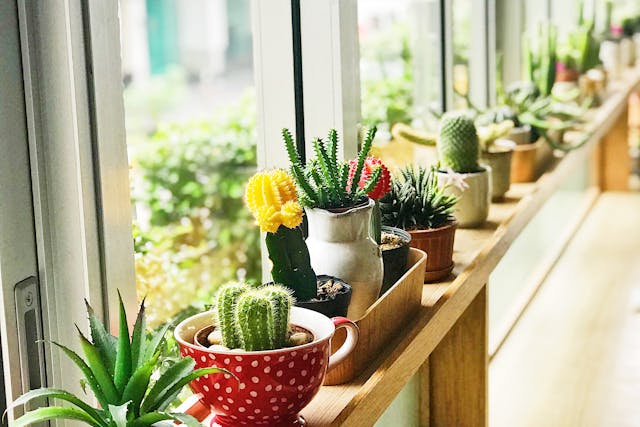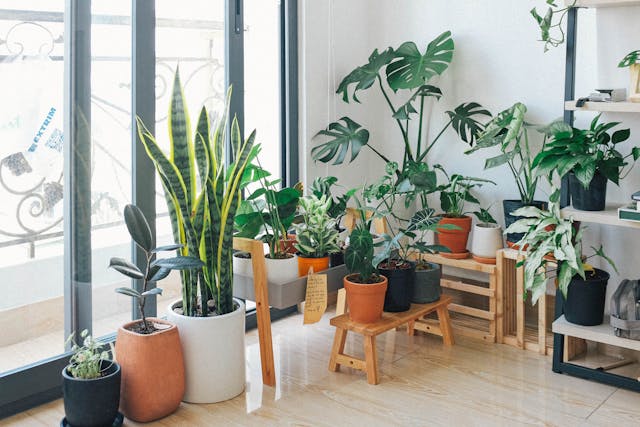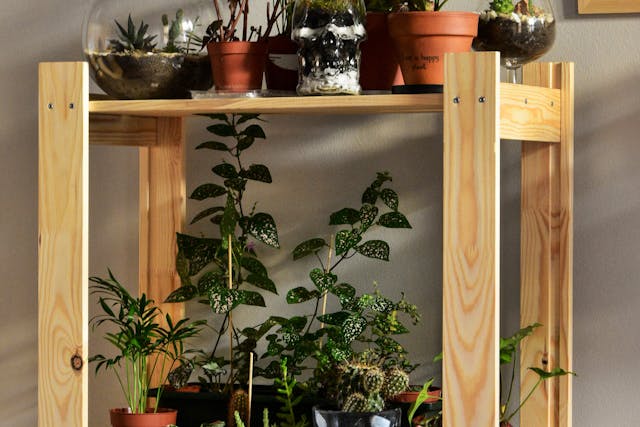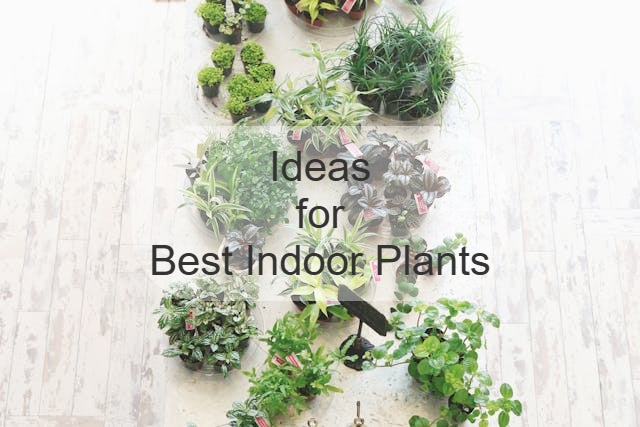Indoor plants do more than beautify your home; they improve air quality, boost mood, and create a tranquil atmosphere. However, selecting the right plants can be overwhelming, especially with so many options available.
This in-depth guide will provide useful ideas for choosing the perfect indoor plants, whether you are a beginner or a seasoned plant lover. From understanding lighting conditions to choosing pet-safe options, you’ll learn how to pick the best plants for your space, style, and lifestyle.
Let’s dive in!

Why Indoor Plants Matter: More Than Just Decoration
The Science Behind Indoor Plants
Indoor plants offer more than aesthetic value. Studies show that they improve concentration, reduce stress, and enhance productivity. NASA research has also confirmed that certain plants can purify indoor air, removing toxins like formaldehyde and benzene.
Mental Health Benefits
Having greenery in your home creates a calming effect. Plants can lower blood pressure, reduce anxiety, and even improve sleep quality. Whether you’re working from home or winding down after a long day, plants make your space more inviting and relaxing.
Understanding Your Space: Light, Humidity, and Temperature
Assessing Natural Light
Before choosing an indoor plant, determine how much sunlight different areas of your home receive:
- Bright, direct light – South-facing windows
- Bright, indirect light – East- or west-facing windows
- Low light – North-facing windows or shaded corners
Use a light meter or simply observe how the sun moves throughout the day to decide where to place your plants.
Humidity Levels
Many indoor plants, especially tropical varieties, thrive in humid environments. If your home is dry, consider misting your plants, using a humidity tray, or placing them in naturally humid areas like the bathroom.
Temperature Considerations
Most indoor plants prefer temperatures between 65-75°F (18-24°C). Keep them away from heaters, air conditioners, and drafty windows, as sudden temperature changes can stress them.
Best Low-Maintenance Indoor Plants for Beginners
If you’re new to plant care, start with hardy plants that require minimal attention.
Top Beginner-Friendly Plants
- Snake Plant (Sansevieria) – Can tolerate low light and infrequent watering.
- ZZ Plant (Zamioculcas zamiifolia) – Nearly indestructible and thrives in any condition.
- Pothos (Epipremnum aureum) – Adapts well to different lighting conditions.
- Spider Plant (Chlorophytum comosum) – Great for hanging baskets and air purification.
Why These Plants Are Easy to Care For
These plants don’t require frequent watering and can thrive in less-than-ideal conditions. Perfect for busy individuals or those with a history of killing houseplants!
Plants for Low-Light Areas: Thriving Without Sunlight
Not every home has bright, sunlit spaces, but that shouldn’t stop you from having greenery.
Related Article: Best Bathroom Plants No Light
Best Low-Light Indoor Plants
- Peace Lily (Spathiphyllum) – Thrives in low light and produces beautiful white flowers.
- Philodendron – Easy to care for and grows well in shade.
- Cast Iron Plant (Aspidistra elatior) – Nearly indestructible and great for dark corners.
Tips for Growing Plants in Low Light
- Rotate plants occasionally to ensure even growth.
- Clean leaves regularly to allow maximum light absorption.
- Consider artificial grow lights if your space lacks natural sunlight.
Air-Purifying Plants: Breathing Fresh Indoors
Indoor air can be polluted with toxins from furniture, cleaning products, and carpets. Fortunately, some plants act as natural air filters.
Related Article: Indoor Plants that Purify the Air Naturally
Best Air-Purifying Plants
- Aloe Vera – Absorbs toxins and releases oxygen at night.
- Boston Fern – Removes formaldehyde and increases humidity.
- Areca Palm – Excellent for filtering air and adding moisture.
How Plants Improve Indoor Air Quality
Plants absorb toxins through their leaves and roots while releasing fresh oxygen. Adding just a few air-purifying plants can make a noticeable difference in your home’s air quality.
Pet-Friendly Plants: Safe Choices for Your Furry Friends
If you have pets, be mindful that some common houseplants can be toxic to them.
Related Article: Best Indoor Plants for Beginners with Dogs
Safe Plants for Cats and Dogs
- Calathea – Beautiful foliage and non-toxic.
- Parlor Palm – Aesthetic and safe for pets.
- Spider Plant – Safe and easy to maintain.
How to Keep Plants and Pets Happy
- Keep toxic plants out of reach.
- Use hanging planters or shelves for delicate plants.
- Train pets to stay away from plant areas.


The Best Indoor Plants for Small Spaces
Living in a small apartment or a home with limited space doesn’t mean you can’t enjoy indoor plants. The right choices can enhance your home without making it feel cluttered.
Related Article: Small Space Indoor Garden Design
Top Compact Indoor Plants for Small Spaces
- Mini Cacti & Succulents – Require very little space and thrive on windowsills.
- Bonsai Trees – A unique, artistic addition for small apartments.
- String of Pearls – A cascading plant perfect for shelves and hanging baskets.
- Lucky Bamboo – Thrives in water and grows vertically, making it ideal for desks and countertops.
Maximizing Greenery in Limited Spaces
- Use Vertical Space – Install wall-mounted planters or floating shelves to keep plants off the floor.
- Go for Hanging Plants – Macrame plant hangers or ceiling hooks are great options.
- Choose Multi-Purpose Plants – Opt for plants that also purify air, like ferns or snake plants.
Even in the smallest apartments, a little greenery can make a big difference in your space’s ambiance.
Aesthetic Appeal: Matching Plants with Home Decor
Indoor plants are more than just greenery; they are a key design element that enhances your home’s aesthetic.
Choosing Plants That Complement Your Interior Design
- Modern & Minimalist Homes – Go for sleek, structured plants like the ZZ Plant or Snake Plant.
- Bohemian & Eclectic Styles – Large, leafy plants like Monstera Deliciosa or hanging vines such as Pothos add a free-spirited vibe.
- Rustic & Farmhouse Style – Opt for Fiddle Leaf Fig or Spider Plants in ceramic or woven baskets.
Using Plants as Decorative Elements
- Table Centerpieces – Small succulents or terrariums add elegance.
- Statement Plants – Large indoor trees, like Rubber Plants or Fiddle Leaf Figs, create focal points.
- Terrariums & Glass Jars – A great way to showcase small plants in modern decor.
By matching your plant choices with your home’s design, you create a harmonious and stylish environment.
Caring for Indoor Plants: Essential Tips for Longevity
Once you’ve chosen the perfect indoor plants, proper care is crucial for keeping them healthy and vibrant.
Watering Best Practices
- Overwatering is the #1 cause of plant death – Always check the soil before watering.
- Use the finger test – If the top inch of soil is dry, it’s time to water.
- Choose self-watering pots if you tend to forget.
Essential Maintenance Tips
- Dust the leaves – A thin layer of dust blocks light absorption.
- Rotate plants – Ensures even growth by exposing all sides to light.
- Trim dead leaves – Helps plants stay healthy and look fresh.
A little regular maintenance keeps your plants thriving for years.
Seasonal Care: Adjusting to Temperature Changes
Plants react differently to seasonal shifts, so adjusting their care routine is important.
Related Article: Good Indoor Plants for Winters
Summer Care Tips
- Increase watering as heat and sun exposure rise.
- Keep plants away from direct afternoon sunlight to prevent scorching.
- Mist tropical plants more frequently to maintain humidity.
Winter Care Tips
- Reduce watering since plants grow slower in colder months.
- Move plants away from cold drafts and heating vents.
- Wipe leaves gently to prevent dust accumulation, which blocks light.
Being mindful of seasonal changes ensures your plants stay healthy all year round.
Common Mistakes to Avoid When Choosing Indoor Plants
Even the most enthusiastic plant lovers make mistakes when selecting indoor plants. Here are common pitfalls to watch out for.
1. Choosing the Wrong Plant for Your Environment
A plant that thrives in high humidity won’t do well in a dry apartment. Always consider your home’s light, temperature, and humidity before buying.
2. Ignoring Growth Potential
Many plants start small but grow large. Make sure you have enough space for mature growth.
3. Overwatering or Underwatering
Watering needs vary by species, so research your plant’s specific requirements.
4. Buying Without Checking for Pests
Always inspect new plants for signs of pests before bringing them home.
Avoiding these mistakes will save you time, money, and frustration in your plant journey.
DIY Indoor Plant Arrangements: Creative Display Ideas
Arranging indoor plants creatively can turn your home into a lush oasis.
Vertical Gardens & Wall Planters
- Install a living plant wall using mounted planters.
- Create a vertical herb garden in the kitchen.
Stylish Tabletop Displays
- Use decorative terrariums for succulents and mosses.
- Arrange multiple plants in a tray with pebbles and candles for a cozy effect.
Floating Shelf Arrangements
- Mix different heights and textures for a dynamic look.
- Use hanging vines like Pothos to add movement to the display.
A little creativity can turn any space into a plant-filled paradise.
Best Places to Buy Indoor Plants: Online vs. Local Shops
When purchasing indoor plants, choosing between online retailers and local nurseries depends on your priorities.
Online Plant Shopping Pros & Cons
✔ Wider selection of rare plants
✔ Convenient home delivery
✖ Risk of shipping damage
✖ Can’t inspect plants in person
Local Nurseries Pros & Cons
✔ Ability to inspect plant health
✔ Expert advice from staff
✖ Limited selection of exotic species
✖ Sometimes pricier than online options
A combination of both options allows you to get the best of both worlds!
Budget-Friendly Plant Shopping: Getting the Best Deals
Plants can be expensive, but there are ways to build your indoor jungle without breaking the bank.
Money-Saving Tips
- Buy Small & Grow Them – Smaller plants are cheaper and grow over time.
- Propagate from Cuttings – Swap cuttings with friends or grow new plants from existing ones.
- Look for Discounted or Clearance Plants – Many nurseries sell imperfect plants at a discount, which can often be revived.
Affordable Plant Alternatives
Instead of buying expensive planters, repurpose mason jars, old teapots, or decorative baskets as plant containers.
With a little creativity, you can have a beautiful indoor garden on a budget.
Frequently Asked Questions About Indoor Plants
1. How often should I water my indoor plants?
It depends on the plant, but a general rule is to water when the top inch of soil feels dry.
2. What are the easiest plants to care for?
Snake plants, pothos, and ZZ plants are among the easiest to maintain.
3. Can indoor plants improve air quality?
Yes! Plants like Aloe Vera, Spider Plant, and Peace Lily can filter toxins from the air.
4. Do indoor plants need fertilizer?
Yes, but only during the growing season (spring and summer). Use a balanced liquid fertilizer once a month.
5. How do I prevent pests on my indoor plants?
Check plants regularly, wipe leaves with a damp cloth, and use neem oil or insecticidal soap if needed.
6. What’s the best indoor plant for a bedroom?
Lavender and snake plants are great choices because they release oxygen at night and promote better sleep.
Final Thoughts
Indoor plants enhance your home by adding beauty, purifying air, and improving well-being. Whether you’re looking for low-maintenance options, pet-friendly varieties, or stylish decor ideas, this guide provides everything you need to choose the perfect indoor plants.
Start small, experiment with different plant types, and enjoy the process of creating your green oasis!

